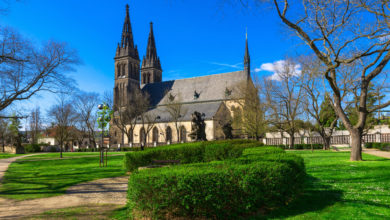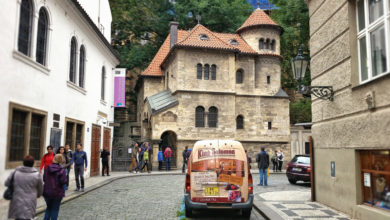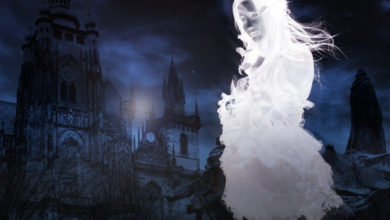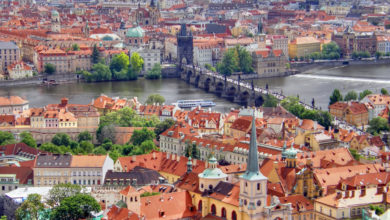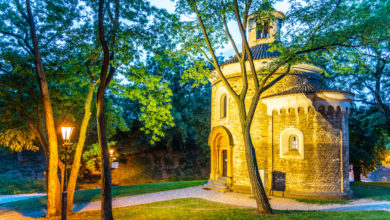Old Town Square to Municipal House Walk
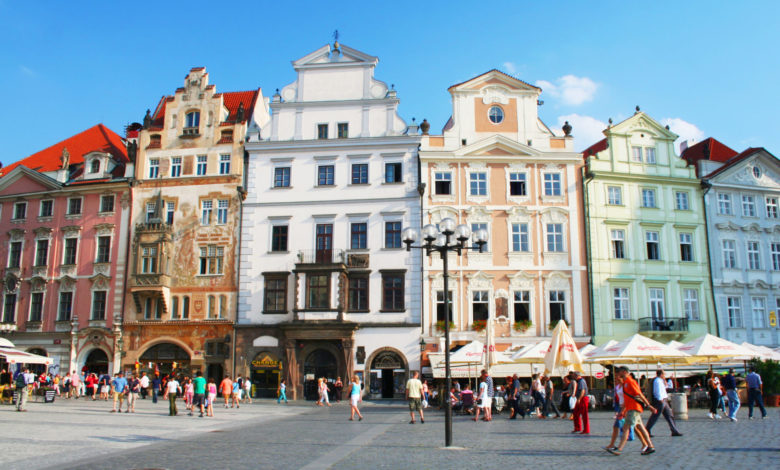
Whereas the modern heart of Prague beats in Wenceslas Square, the city’s past is kept alive in the Old Town Square. Although it has inevitably become in some ways a tourist trap – what with its top dollar ice cream stalls, never-ending parties of guided tours, and invading Segways (look out for these contraptions) – one cannot help but marvel at the immense amount of preserved history to be found huddled in this one small space.
The Old Town Square has always been a centre of the celebration. Nowadays, crowds throng here for the final of an international ice hockey match, or to take in the delights of the Christmas market, but in the past, people assembled for arguably more decisive moments, such as the welcoming in of the foundation of the Republic of Czechoslovakia in 1918, and 1989’s wild celebrations in which Czechs rang in the return of democracy to their country.
Yet the Square is not just a centre of celebration; it also harbours a much darker history – one of invasion, execution and defenestration (more of which in a moment).
1. A hub of tourists is almost permanently centred around the Square’s Old Town Hall – a 14th-century building of which the centrepiece is its Astronomical Clock, added in 1410 by imperial clockmaker Mikuláš of Kadaň. On the hour, a sea of tourists gaze upwards at the clock, as a figurine depicting Death tolls a bell and inverts his hourglass, and the 12 Apostles parade past little windows above the clock. In recent years, because many have found this scene to be somewhat anti-climactic, a trumpeter also bellows out of fanfare from the top of the tower. The clock faces itself is almost impossibly intricate; it depicts 24-hour European time, Traditional Bohemian time and the hours of sunrise and sunset.
2. The most infamous moments in the Town Hall’s history are its defenestrations (the Czech-originating word which means to be hurled out of an open window). The first of these took place in 1419 when an enraged mob of Hussites killed seven city council members, and the second in 1618, when four Catholic Lord Regents endured the same fate. However, some sources claim that this second group of victims landed on a huge manure pile, thereby walking away from the incident unscathed. If you are lucky enough to time it right, you may catch one of the spectacular light and sound shows that are projected onto the tower, recalling its colourful history.
3. Off to the right of the clock and towards the middle of the Square stands the oxidized Jan Hus Memorial. This unlikely national hero is celebrated on a national holiday every 6th of July. Once controlled by the Hussites and towering above the Old Town Square is the Church of Our Lady before Týn. It is one of the city’s biggest churches and another architectural achievement of Charles IV (he of Charles Bridge fame). That said, the structure you see before you took some time to complete. Work began on the church in 1365, but the south tower wasn’t finished off until 1511. Look out for the four small spires positioned around the major ones — this denotes a site of execution, a place where numerous Hussites lost their head heads. The church may have a Gothic exterior but crane your head around its doorway, and another story is revealed; that of heavy Baroque influence. Inside, you will find the oldest pipe organ in Prague.
4. Exiting the Old Town Square can prove a tricky business, what with the combination of slim-line passageways and perpetual swarms of tourists. Your best option is to make your escape by way of Železná, which will lead you directly to a more open, tranquil space and the Estates Theatre – the neoclassical structure that looks a bit like a green wedding cake. This theatre represents Mozart’s infatuation with Prague, and it is here that the genius conducted his world premiere of Don Giovanni. Outside the front of the theatre, crouches the ghoulish Commendatore statue from that opera. You might also recognise the blue velvet interior, the location for the Oscar-winning film Amadeus, which Czech director Miloš Forman filmed.
5. To the left of the Estates Theatre is the Carolinum, founded by Charles IV in 1348 as the first university in Central Europe. The complex was fitted out with lecture halls, a spa and bizarrely, a prison during its expansion. The outstanding feature of the building is its Gothic oriel window, originating from 1370 and adorned with ornamental stonework that would take hours, if not days, to appreciate fully. Today the Carolinum is used largely for graduation ceremonies.
6. Walk down the right side of the Estates Theatre and follow Ovocný trh round to the left, where you will stumble upon the House of the Black Madonna – a scarce example of Czech Cubism, a movement which existed the very breadth of time between 1910 and 1914, and was killed off by the advent of World War One. The House of the Black Madonna houses two places of great interest; the first is a Cubist museum and gift shop; the second, the painstakingly restored Grand Café Orient, where you can enjoy a thick hot chocolate or glass of wine while listening to classical music tinkled out on the grand piano. If this building has whetted your appetite for Czech Cubism, you should also see the Josef Chochol-designed villa located on the river up towards Vyšehrad.
7. Now join onto Celetná, where you will immediately meet the gaze of the Powder Tower – a Gothic structure that was once part of the city’s defences. It was also the place where – until 1836 – Bohemian monarchs would pass through on their way to the coronation at St. Vitus Cathedral. Today, you can walk up its 186 steps and enjoy one of the best views of New Town.
8. Attached to the Powder Tower is arguably Prague’s finest example of Art Nouveau artistry. It results from the combined efforts of many of the country’s foremost artists and architects of the time, including Alfons Mucha, who created some of the murals inside. Inside, there is a café, two restaurants and the recently restored American Bar, where they’ll mix you a Manhattan in style. For an Art Nouveau dining experience just as lavish but with a more attractive price tag, cross Náměstí Republiky and walk for five minutes down Na poříčí, where Café Imperial will appear on your left. Here you can enjoy delicious eggs benedict in Egyptian-influenced splendour.
This tour can be walked on your own (self-guided tour), or we can arrange for you a professional English-speaking guide. The tour guide can even tailor this walk to your special needs; for example, recommend a place where to stop for lunch, including a river cruise or tram ride if you are tired of walking, etc. The guide can pick you up at your hotel, or you can arrange to meet anywhere in the city. Please email us your details for a price quote.

